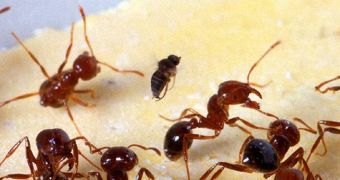This behavior is better known by most people as "playing possum" and by scientists as thanatosis ("putting to death" in Greek). When threatened or harmed, some animals mimic the appearance and smell of a sick or dead animal. The behavior is mostly known in opossums, but in reality it is practiced by various animals, from some snakes and toads to wasps and crickets. A new research published in the journal "Naturwissenschaften" shows that fire ants do it, too.
The research team noticed by studying close-up videos of ants that, when threatened, the young ants employed thanatosis to fake out an aggressor.
"No one has ever reported this before, and it was a big shock to me. Ants from an attacking colony will come up to inspect them, and they'll be curled up just like a dead ant. Then moments later they uncurl and walk away," said lead researcher Deby Cassill, an evolutionary biologist at the University of South Florida St. Petersburg.
The team observed that with aging, the fire ants, which can live from 6 months up to a year, lose this behavior. Middle-aged ants have the tendency to flee, while the older ants are the most aggressive and attack furiously.
"All worker ants are sterile females, so it's the cranky old ladies who are the ones fighting to the death," said Cassill.
The different behaviors at different ages could be connected with the vulnerability of each state.
"The exoskeletons of young ants are actually quite soft, so they're more vulnerable to attack than older ants with thicker, tougher body parts. They also don't have a lot of attacking power because of the softness of their exoskeleton. The behavior is likely inherited, through genes and other factors. By studying individual ants, you find that they're hugely different from one to another. Some work harder than others, some are more submissive, and they just seem to have this semblance of personality," said Cassill.

 14 DAY TRIAL //
14 DAY TRIAL //